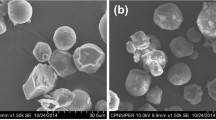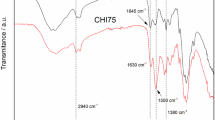Abstract
The purpose of this research was to investigate the potential use of anionick-carrageenan and nonionic hydroxypropyl-methylcellulose (HPMC, K4) to improve the matrix integrity of directly compressed chitosan tablets containing naproxen sodium, an anionic drug. The influence of buffer pH and drug:polymer ratio on the water uptake, matrix erosion, and drug release were studied. The rapid release of naproxen sodium was seen from matrices containing 100% chitosan due to loss in the matrix cohesiveness; whereas, it was relatively slow for matrices containing optimum concentration ofk-carrageenan. In-situ interaction between oppositely charged moieties resulted in the formation of polyelectrolyte complexes with stoichiometric charge ratios of unity. Fourier transform in frared (FTIR) spectroscopy and powder x-ray diffraction (PXRD) data confirmed the importance of ionic bonds in polyelectrolyte complexation. The ionic interactions between polymers were absent in matrices containing HPMC and the integrity of tablets was improved owing to the presence of viscous gel barrier.
The reasons for retarded release of naproxen sodium from the chitosan matrices at different pH include poor aqueous solubility of drug, the formation of a rate-limiting polymer gel barrier along the periphery of matrices, the interaction of naproxen sodium with protonated amino, groups of chitosan, and the interaction of ionized amino groups of chitosan with ionized sulfate groups ofk-carrageenan.
Similar content being viewed by others
References
Bonferoni MC, Rossi S, Ferrari F, Bettinetti GP, Caramella C. Characterization of diltiazem lambda carrageenan complex.Int J Pharm. 2000;200:207–217.
Graham H, Baker Y, Nojoku-obi A. Complex formation between hydrocolloids and tranquilizers and hypotensive agents.J Pharm Sci. 1963;52:192–198.
Miyazaki S, Nakayama A, Oda M, Takada M, Attwood D. Drug release from oral mucosal adhesive tablets of chitosan and sodium alginate.Int J Pharm. 1995;118:257–263.
Tapia C, Costa E, Sapag-Hagar J, Valenzuela F, Basualto C. Study of the influence of the pH media dissolution, degree of polymerization, and degree of swelling of the polymers on the mechanism of release of diltiazem from matrices based on the mixtures of chitosan/alginate.Drug Dev Ind Pharm. 2002;28:217–224.
Tapia C, Escobar Z, Costa E, et al. Comparative studies polyelectrolyte complexes and mixtures of chitosan-alginate and chitosan-carrageenan as prolonged diltiazem clorhydrate release systems.Eur J Pharm Biopharm. 2004;57:65–75.
de la Torre PM, Enobakhare Y, Torrado S, Torrado S. Interpolymer complexes of poly(acrylic acid) and chitosan, influence of the ionic hydrogel forming medium.Biomaterials. 2003;24:1499–1506.
Tomida H, Nakamura C, Kiryu S. A novel method for the preparation of controlled release theophylline capsules coated with a polyelectrolyte complex ofk-carrageenan and chitosan.Chem Pharm Bull (Tokyo). 1994;42:979–981.
Winterowd J, Sanford P eds. Chitin and chitosan.Food Polysaccharides and Their Applications. 2nd ed. New York, NY: Marcel Dekker Inc; 1995:441–462.
Rege PR, Shukla DJ, Block LH. Chitinosan-drug complexes: effect of electrolyte on naproxen release in vitro.Int J Pharm. 2003;250:259–272.
Errington N, Harding S, Varum KM, Illum L. Hydrodynamic characterization of chitosan varying in molecular weight and degree of deacetylation.Int J Biol Macromol. 1993;15:112–117.
Bartkowiak A, Hunkeler D. Carrageenan-oligochitosan microcapsules: optimization of the formation process.Colloids Surf B Biointerfaces. 2001;21:285–298.
Sezer AD, Akbuga J. Controlled release of piroxicam from chitosan beads.Int J Pharm. 1995;121:113–116.
Genta I, Perugini P, Pavanetto F. Different molecular weight chitosan microspheres: influence on drug loading and drug release.Drug Dev Ind Pharm. 1998;24:779–784.
Akbuga J, Dumaz G. Preparation and evaluation of cross-linked chitosan microspheres containing furosemide.Int J Pharm. 1994;111:217–222.
Thacharodi D, Rao KP. Release of nifedipine through cross-linked chitosan membranesInt J Pharm. 1993;96:33–39.
Filipovic-Grcic J, Becirevic-Lacan M, Skalko N, Jalsenjak I. Chitosan microspheres of nifedipine and nifedipine-cyclodextrin complexes.Int J Pharm. 1996;135:183–190.
Thanoo BC, Sunny MC, Jayakrishnan A. Cross-linked chitosan microspheres: preparation and evaluation as a matrix for the controlled release of pharmaceuticals.J Pharm Pharmacol. 1992;44:283–286.
Jameela SR, Jayakrishnan A. Glutaraldehyde cross-linked chitosan microspheres as a long acting biodegradable drug derlivery vehicle: studies on the in vitro release of mitoxantrone and in vivo degradation of microspheres in rat muscle.Biomaterials. 1995;16:769–775.
Amaral HM, Sousa Lobo JM, Ferreira DC. Effect of hydroxypropyl methylcellulose and hydrogenated castor oil from sustained release naproxen tablets.AAPS PharmSciTech. 2001;2:E6.
Iqbal Z, Babar A, Ashraf M. Controlled release naproxen using micronized ethylcellulose by wet granulation and solid dispersion method.Drug Dev Ind Pharm. 2002;28:129–134.
Seedher N, Bhatia S. Solubility enhancement of Cox-2 inhibitor using various solvent systems.AAPS PharmSciTech. 2003;4:E33.
Curotto E, Aros F. Quantitative determination of chitosan and percentage of free amino groups.Anal Biochem. 1993;211:240–241.
Caram-Lelham N, Cleland RL, Lars-Olof S. Temperature and salt optimization of kappa carrageenan fractionation by DEAE-cellulose.Int J Biol Macromol. 1994;16:71–75.
Paradkar A, Chauhan B, Naim S, Samuel B. Effect of potassium chloride and cationic drug on swelling, erosion, and release fromk-carrageenan matrices.AAPS PharmSciTech. 2004;5:E25.
Picker KM. Matrix tablets of carrageenans. II. Release behavior and effect of added cations.Drug Dev Ind Pharm. 1999;25:339–346.
Sakiyama T, Chia-Hong C, Fujii T, Yano T. Preparation of a polyelectrolyte complex gel from chitosan and kappa-carrageenan and its pH sensitive swelling.J Appl Polym Sci. 1993;50:2021–2025.
Gupta VK, Madhusudan H, Wheatley TA, Price JC. Controlled release tablets from carrageen: effect of formulation storage and dissolution factors.Eur J Pharm Biopharm. 2001;51:242–248.
Felt O, Buri P, Gurny R. Chitosan: a unique polysaccharide for drug delivery.Drug Dev Ind Pharm. 1998;24:979–993.
Picker KM. Carrageenans used for tabletting and controlled release. Proceedings of 2nd World Meeting: May 25–28, 1998; Paris, France.
Bonferoni MC, Rossi S, Ferrari F, Bettinetti GP, Caramella C. Factorial analysis of the influence of dissolution medium on drug release from carrageenan diltiazem complexes.AAPS PharmSciTech. 2000;1:E15.
Huang RG, Schwartz JB, Ofner CM. Microencapsulation of chlorpheniramine maleate-resin particles with crosslinked chitosan for sustained release.Pharm Dev Technol. 1999;4:107–115.
Hugerth A, Lelham NC, Sundelof LO. The effect of charge density and conformation the polyelectrolyte complex formation between carrageenan and chitosan.Carbohydr Polym. 1997; 34:149–156.
Bonferoni MC, Rossi S, Ferrari F, Bertoni M, Bolhuis GK, Caramella C. The employment of lambda carrageenan in a matrix system. III. Optimization of a lambda carrageenan-HPMC hydrophilic matrix.J Control Release. 1998;51:231–239.
Sipahigil O, Dortune B. Preparation and in vitro evaluation of verapamil HCL and ibuprofen containing carrageen beads.Int J Pharm. 2001;228:119–128.
Liu LS, Liu SQ, Sy NG, Froix M, Ohno T, Heller J. Controlled release of interleukin-2 for tumour immunotherapy using alginate/ chitosan porous microspheres.J Control Release. 1997;43:65–74.
Zerrouk N, Mennini N, Maestrelli F, Chemtob C, Mura P. Comparison of the effect of chitosan and polyvinylpyrrolidone on dissolution properties and analgesic effect of naproxen.Eur J Pharm Biopharm. 2004;57:93–99.
Paula HCB, Gomes FJS, de Paula RCM. Swelling studies of chitosan/cashew nut gum physical gels.Carbohydr Polym. 2002;48:313–318.
Author information
Authors and Affiliations
Corresponding author
Additional information
Published: June 15, 2007
Rights and permissions
About this article
Cite this article
Bhise, K.S., Dhumal, R.S., Chauhan, B. et al. Effect of oppositely charged polymer and dissolution medium on swelling, erosion, and drug release from chitosan matrices. AAPS PharmSciTech 8, 44 (2007). https://doi.org/10.1208/pt0802044
Received:
Accepted:
DOI: https://doi.org/10.1208/pt0802044




